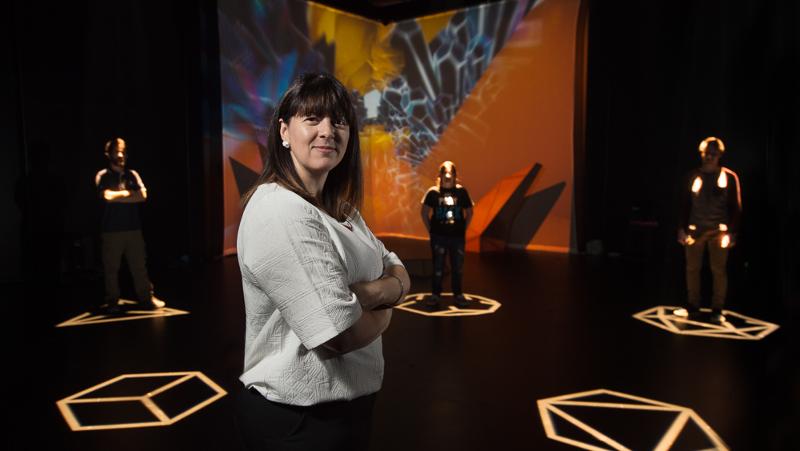
Pokémon Go is already a goner – make way for room-sized augmented reality.
QUT researchers have created a multidimensional, real-time, augmented reality experience, in a room that feels like a Star Trek-style holodeck.
In the Museum of Colliding Dimensions, a mysterious rift has opened in the walls of QUT’s new Creative Industries Precinct – revealing an alien world of Platonic shapes that reacts to your presence in the room.
Museum visitors can explore this world both physically and virtually through a unique application of cutting-edge technologies – an experiment few technologists have tried.
Multimedia:
The tiny team of four fresh QUT creative industries graduates and design academic Dr Deb Polson used game engine Unity to mash together tried-and-trusted analogue theatre hardware with the very latest in projection mapping, VR, industrial laser scanning, multi-touch and dynamic light and sound technologies.
“It’s quite a spectacle of an installation - we don’t know of any other project that has used a game engine to display and render a 3D world across so many platforms all at once and in real time,” Dr Polson said.
“We pushed Unity to the limits to force it to control live space and the complex interaction of all these technologies within it.
“We’ve tried to use every bit of technology in a new way, adopting it but subverting it at the same time.”
In this mock museum, every component responds to your movements in the room – lighting, soundtrack, even the crystalline structures within the rift in the corner.
And when you try the VR headset you don’t just watch a passive video – you see the same people you are in the room with, in real time (but as shapes),but experiencing the real world from a completely different dimension.
“We’ve reversed that usual trend – turning VR into AR rather than the other way around,” Dr Polson said.
“We wanted to help people move seamlessly between the physical and digital worlds within the museum, which is a great experience particularly for those who haven’t played much with VR and AR before.
“The room is one simple alien world, but it’s being experienced by patrons through multiple layers of AR. Once you’re comfortable physically interacting with the projection mapping of the rift you can wade deeper into the VR world.”
Dr Polson said the museum represented more than a unique mashup of technologies – it’s about innovative thinking.
“This is an exercise in activating mundane spaces into playful, contemplative and informative environments through careful collaboration between the arts and sciences,” Dr Polson said.
The Museum of Colliding Dimensions is the first project fledged from Studio 110, Australia’s only dedicated creative industries R&D lab and part of QUT’s new Creative Industries Precinct expansion.
QUT was the world’s first university to establish a faculty of creative idustries.
Studio 110 is a black box R&D lab with full lighting and digital production capabilities. It combines robust physical infrastructure – including full wall and ceiling grid, suspension and belaying points, rigging, sound and video projection – with connection to a full digital production network.
The museum and lab will demonstrate to the public how an AR world can be experienced, during QUT’s free CreateX festival Sunday August 28.
And yes, it also comes with a Pokémon Go-style location-based AR game app the public can play on their smart devices as they explore the new creative industries facilities at the festival and find clues about the secrets of this AR alien world.
For Dr Polson, it’s not the experience but the creators that excites her the most: 3D-artist Wade Taylor, programmer Ryan Quagliata, fabricator Cat Wilkinson and sound designer Nathan Corporal.
“This is a small team of new graduates with diverse skills,” said Dr Polson.
“Every one of us has had to expand our discipline skills to make this project happen.
“We create new skill sets for creative practitioners when we run experiments like these.
“By involving graduates we’re also testing what we as educators need to teach in the curriculum – how to grow the curriculum to meet the changing demands of industry and technology.”
Media contacts:
Kate Haggman, QUT Media, +61 7 3138 0358 or kate.haggman@qut.edu.au
After hours Rose Trapnell, +61 407 585 901 or media@qut.edu.au


